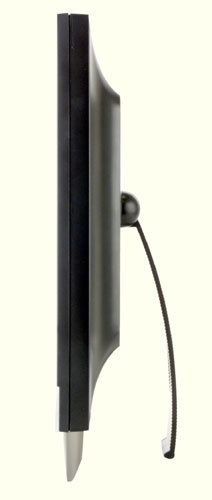Comparison Of 15" LCD Monitors - Part I
Cornea MP503

Be prepared for a surprise when you unpack the Cornea MP503 - it looks incredibly similar to the Belinea 10 15 35. It looks suspiciously as if a designer sold the same design to two different companies. Both monitors have the same plastic case, the same small bipod attached to the bottom of the panel, and the same plastic retaining stand. Its flimsy appearance notwithstanding, the monitor is well-balanced and will stand up well to all the dusting that its black case will make necessary.
Moving on to its technical specifications, the two monitors only share two points - a response time of 40 ms and an effective color depth of 16 million colors. Belinea is the better deal for the remaining features. The Hyundai panel integrated in the MP503 uses technology that was state of the art a year ago. Its contrast ratio is a paltry 200:1 and its brightness only reaches 200 cd/m². Or at least, that's what the theoretical equations predict and our rough measurements tell us. Interestingly enough, though, our measurements appear to put the MP503 at an unfair disadvantage, since we were pleasantly surprised by this monitor during the tests.
Cornea claims that the MP503 has a response time of 40 ms. When we put the monitor to the test, we discovered that, while scrolling through Web pages is bearable, certain visual problems are caused during games whenever the mouse is moved too quickly. Strategy games should be perfectly playable. But First Person Shooter games such as Quake and Red Faction, which we used during the tests, are less than ideal with the MP503. The background tends to blur whenever the characters move, while rapid turns cause bars to appear in the middle of the screen.
Like the other monitors with a contrast ratio of 200:1, once it has been set properly, the MP503 passes the color test with (excuse the pun) flying colors. The only colors that tend to be displayed as black are very dark hues (4 to 1/255), particularly shades of red and blue.

As to the MP503's ergonomic features and its user-friendliness, although the auto-adjustment feature is fast, we had some problems using it to adjust both phase and clock. The display always appeared to be slightly blurred. This shows how vital it is to emphasize this kind of error, which would normally not be important, had the parameters been managed properly. Unlike the vast majority of its rivals, there is no way to adjust either phase or clock manually in the OSD menu. You just have to try the auto-adjustment feature again. In our case, though, we didn't notice any improvement whatsoever in the display.
Let's just hope that this defect was just an anomaly of the monitor we had borrowed. If our monitor was, in fact, the exception and not the rule, the MP503 offers very good value despite its problems during games. It is one of the most inexpensive displays on the market.
Stay on the Cutting Edge
Join the experts who read Tom's Hardware for the inside track on enthusiast PC tech news — and have for over 25 years. We'll send breaking news and in-depth reviews of CPUs, GPUs, AI, maker hardware and more straight to your inbox.
Most Popular

